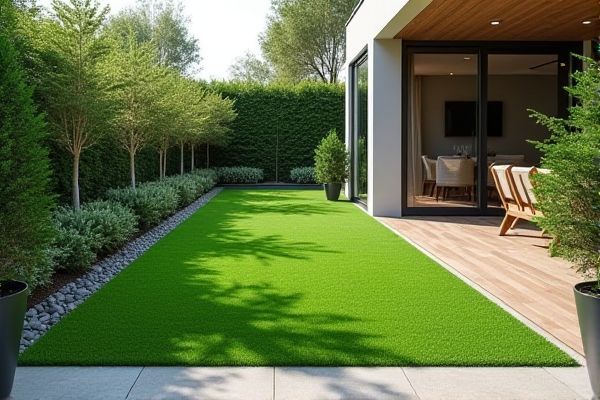
Artificial grass offers a low-maintenance, durable alternative to natural grass for terraces, saving you time on watering and mowing while maintaining a green appearance year-round. Explore the rest of this article to discover key differences and decide which option best suits your outdoor space needs.
Table of Comparison
| Feature | Artificial Grass | Natural Grass |
|---|---|---|
| Maintenance | Low maintenance; no watering, mowing, or fertilizing | High maintenance; requires regular watering, mowing, and fertilizing |
| Durability | Long-lasting; withstands heavy foot traffic and weather | Prone to wear, patchy areas under heavy use |
| Installation | Quick to install; suited for terraces and rooftops | Slower to establish; needs suitable soil and drainage |
| Environmental Impact | No natural ecosystem; potential microplastic pollution | Supports biodiversity; natural cooling and carbon absorption |
| Appearance | Consistent green year-round; may look artificial on close inspection | Natural look; changes with season and weather conditions |
| Cost | Higher upfront cost; lower long-term maintenance expenses | Lower initial cost; higher ongoing maintenance expenses |
Introduction to Terrace Flooring Options
Artificial grass offers a low-maintenance and durable alternative to natural grass for terrace flooring, providing a consistently green and clean surface year-round. Natural grass enhances your terrace with a fresh, organic feel but requires regular watering, mowing, and care to maintain its appearance. Choosing between artificial and natural grass depends on your preference for ease of upkeep versus the authentic texture and scent of real greenery.
Key Differences: Artificial Grass vs. Natural Grass
Artificial grass offers low maintenance, requiring no watering, mowing, or fertilizing, making it ideal for terraces with limited outdoor space or water restrictions. Natural grass enhances outdoor aesthetics and air quality through its natural photosynthesis but demands regular care, including watering, trimming, and pest control. Durability is a significant factor: artificial turf withstands heavy foot traffic and harsh weather, while natural grass can wear down and develop uneven patches over time.
Installation Process: What to Expect
Installing artificial grass on your terrace involves a streamlined process that includes surface preparation, drainage setup, and secure turf placement, typically completed within a day. Natural grass installation requires soil conditioning, seeding or sod laying, and a longer establishment period with consistent watering and maintenance. You can expect artificial grass installation to offer a faster, low-maintenance solution compared to the time-intensive care natural grass demands.
Maintenance Requirements Compared
Artificial grass on terraces requires minimal maintenance, needing occasional brushing and rinsing to remove debris, while natural grass demands regular watering, mowing, fertilizing, and pest control. The synthetic option eliminates the risk of patches and weeds, ensuring a consistently green appearance year-round. Natural grass offers better environmental benefits like oxygen production and carbon absorption but entails higher labor and water costs.
Durability and Longevity
Artificial grass offers superior durability and longevity compared to natural grass, withstanding heavy foot traffic and harsh weather without fading or wearing out for up to 15-20 years. Natural grass on terraces requires constant maintenance, including watering, mowing, and reseeding, and is susceptible to damage from drought, pests, and foot traffic, often needing replacement within a few years. Choosing artificial grass for your terrace ensures a long-lasting, low-maintenance surface that retains its appearance and functionality over time.
Environmental Impact and Sustainability
Artificial grass reduces water consumption and eliminates the need for fertilizers and pesticides, significantly lowering chemical runoff and resource use compared to natural grass. However, it involves synthetic materials that contribute to microplastic pollution and challenges in recycling at the end of its lifespan. Natural grass supports biodiversity, carbon sequestration, and soil health but requires ongoing water, fertilizer, and pesticide inputs that impact sustainability.
Cost Analysis: Initial and Ongoing Expenses
Artificial grass for terraces typically incurs higher initial installation costs ranging from $8 to $15 per square foot, compared to natural grass which costs around $1 to $3 per square foot for sod and soil preparation. Ongoing expenses for artificial grass are significantly lower due to minimal maintenance requirements, with occasional cleaning and infill replacement, while natural grass demands continuous costs for watering, fertilizing, mowing, and pest control. Over a 10-year period, artificial grass can result in cost savings of up to 50% by eliminating water bills and reducing labor-intensive upkeep.
Comfort and Aesthetic Appeal
Artificial grass offers consistent softness and a lush green appearance year-round, enhancing terrace comfort without the need for regular maintenance. Natural grass provides a cooler surface and a more authentic, vibrant aesthetic that changes with seasons, contributing to a dynamic outdoor ambiance. Both options improve terrace appeal, with artificial grass excelling in durability and minimal upkeep while natural grass delivers a fresher sensory experience.
Safety and Usability for Families and Pets
Artificial grass offers a consistent, non-toxic surface free from pesticides and allergens, making it safer for children and pets on terraces. Natural grass can harbor insects, mud, and uneven patches that may pose tripping hazards and require ongoing maintenance to ensure safety. Families often prefer artificial turf for its durability, easy cleaning, and slip-resistant properties, enhancing usability in high-traffic terrace areas.
Making the Best Choice for Your Terrace
Choosing between artificial grass and natural grass for your terrace depends on factors like maintenance, durability, and aesthetics. Artificial grass offers low maintenance, consistent greenery, and resilience against weather, making it ideal for busy lifestyles. Your choice should balance the natural feel of grass with the convenience and longevity of synthetic turf for the best terrace experience.
 homyna.com
homyna.com